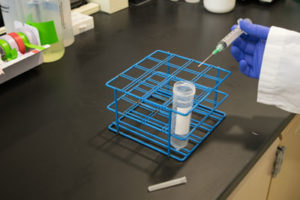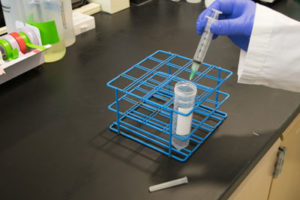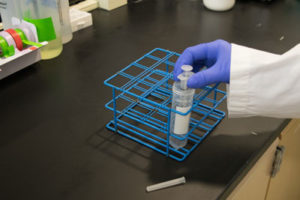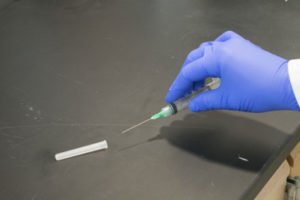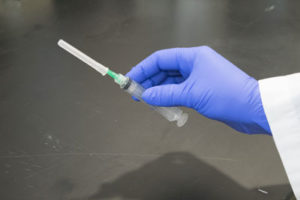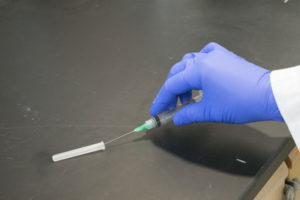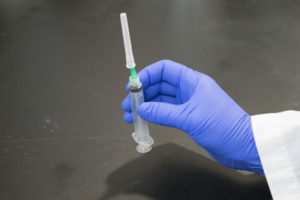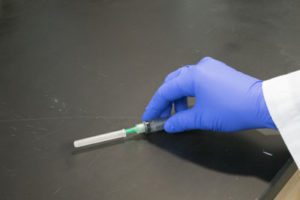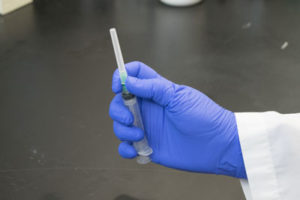Biosafety
Safe Handling of Sharps in the Biological Research Laboratory
Sharps injuries are a significant injury and health hazard for laboratorians and animal care workers and are most often preventable. A penetration of the skin with a biologically contaminated sharp device is one of the most effective means of transmitting infectious agents. These injuries also result in a number of direct and indirect organizational costs (CDC ‘Stop Sticks’ campaign). In a laboratory or animal care setting, the potential for exposure to zoonotic agents must always be considered.
A sharp is an item that is designed to cut or puncture skin. Sharps include unused, disinfected or contaminated, needles, syringes with needles, scalpel blades, lancets and razor blades. Broken vials and slides with infectious agents or human blood are also considered sharps. The need for the use of sharps in science has diminished over time with the advancement of instrumentation and other life science-related procedures but there still remains a legitimate need for sharps use.
The Office of Biosafety has developed a best practice guidance document regarding the use of sharps used in biological research at the University of Georgia. You may also read more information on the handling of sharps in the laboratory by reviewing the University of Georgia’s Institutional Biosafety Manual and the Exposure Control Plan that outlines appropriate practice with sharps.
Please observe the following precautions and processes to help prevent injuries from needles and sharps:
Sharps reduction
Each laboratory should have a sharps reduction policy. A sharps reduction policy is the first step in reducing needlesticks and sharps injuries. Identify all sharps that are being used as part of any procedures and determine whether or not an alternative is available to perform the procedure without using a device sharp enough to puncture skin. An example of sharps reduction is replacing a regular needle used to disperse clumped cells with a blunt end/tip needle.
Safer sharps devices
Safer sharps devices have engineering controls that are built into the product and prevent sharps injuries. Safer sharps devices come in various types ranging from devices that contain a protective shield over the needle to those that do not use a needle at all, and including improved sharps containers. All traditional devices have safer alternatives that are highly effective in substantially reducing injuries. For instance, almost 83% of injuries from hollow-bore needles can be prevented with use of safer sharps devices (Ippolito et al. 1997). The University of Virginia International Health Care Worker Safety Center has an extensive listing of safety devices and manufacturers.
Training, training, training
Improper use of sharps devices and poor technique (i.e., recapping/resheathing) can increase the risk of sustaining a sharps exposure or other injury. Assure that lab personnel are properly trained by principal investigators, lab supervisors, or senior lab personnel on new techniques and safety equipment in a controlled setting before employing these in a procedure involving biological (or other hazardous) materials. Please contact the Office of Biosafety with any questions regarding safe sharp handling.
Safe and appropriate use of scalpels
- Do not use disposable scalpels that require you to place your fingers next to the blade and apply force to snap off the shield.
- Use disposable safety scalpels with fixed blades whenever possible. These devices eliminate the need to remove a blade, which requires significant skill to perform safely.
- If you must use a reusable scalpel, consider using blades with engineered safety features that allow for enclosure of the blade before blade removal. If safety-engineered blades are not an option, forceps must be used to remove the blade.
- Do not use scalpel blades without a handle. The handle serves as a means to control the blade and puts a barrier between your hand and the sharp edge
- Do not “saw” with a scalpel or put excessive force on it. These actions can cause the blade to snap creating an aerosol and flying debris hazard as well as a sharps exposure hazard. Use knives for tasks that require greater cutting action.
Know your environment
- When organizing the sharps in the work area, the sharps should be pointed away from the handler and receiving personnel. Always keeping sharps pointed away from the handler and any receiving personnel will decrease the chances of an injury.
- Never temporarily place exposed sharps on a countertop.
- For disposable sharps, have a sharps container readily available, preferably within arm’s reach for disposal of sharps immediately after use. Dispose of sharps directly into the container and immediately after use if your procedures permit you to do so. Do not have personnel stationed between you and the sharps container.
- Do not leave sharp devices out in the environment any longer than necessary.
- Confirming that sharps are not present will ensure that no injuries occur.
- Do not place sharp devices in your lab coat pocket.
Two hands are NOT better than one
- Recapping needles (please see below), or passing sharp devices (i.e., scalpels) from one person to another, are common examples of “two-handed” techniques that can lead to hand injuries with contaminated sharps. Eliminate these techniques whenever possible, or modify the technique to eliminate the risk to the non-dominant hand.
- When conducting an activity that requires a sharp device to be passed between personnel, adopt a system to prohibit both personnel from grasping the device at the same time through the use of zones and communication. Assisting personnel should not cross zones and should always have their hands as far away from the sharps area as feasible. Communication between the sharps handler and the person assisting is critical. Use common phrases such as “sharps hazard” and “sharps clear”. An example of passing a sharp would be while placing a sharps tip into a conical tube, vocalize “sharps present” and then vocalize “sharps clear” once the sharps tip is placed in the conical tube. This ensures the assisting personnel are not grasping the sharps device at the same time.
When passing a sharp, place the sharp tip down into a conical tube for the other person to grasp while using common phrases such as “sharps present or “sharps clear”.
Use an appropriate sharps container for disposal of sharps waste
An appropriate container is leak-proof on the sides and bottom, has a means of permanent closure, bears the biohazard symbol, and is designed for sharps collection.
- Make sure the lid is properly installed before putting the container into use
- Close the lid for transport or storage purposes. Permanently close the lid for disposal purposes.
- Do not overfill sharps container. Sharps containers are considered full when they are ¾ full.
If you sustain an injury with a sharp, take appropriate action to minimize lab-acquired infection risk
- Milk the wound and thoroughly cleanse the wound with soap and water. Then, cover it with a bandage.
- Report the injury to your supervisor as soon as possible.
- Report to the Occupational Health physician immediately if the injury requires medical attention due to the severity of the skin damage OR if the injury involved exposure to human-derived materials, non-human primate body fluids, or body fluids from animals that were potentially exposed to pathogens or viral vectors. (NOTE: The Office of Biosafety must be notified by the supervisor or the Occupational Health physician if the injury involved exposure to infectious agents or materials containing recombinant DNA molecules.)
- For more information about incident or accident reporting or response, see:
Recapping: Special Circumstances for Animal-Related Activities
The prohibition of recapping needles under the OSHA BBP Standard was based on several years of collected data demonstrating that the majority of sharps injuries in human healthcare occur from recapping (62%) and improper disposal techniques. Although this data was collected in a different occupational setting, many of the techniques and devices are the same as those used in the animal research and clinic environments. The safety message is the same: recapping needles is an infectious disease exposure risk.
Under special circumstances when a syringe and needle must be used as a “specimen container,” it is recognized that recapping may be necessary. Outside of those circumstances, recapping should not be performed unless the circumstances are such that you will further increase your risk of a needlestick exposure by not recapping. Recapping is considered a poor scientific technique and is discouraged unless warranted as described above. It is strongly encouraged that engineering controls (shields and special caps) be used that can reduce the risk of this technique. If the conditions of the procedure do not warrant the practice of recapping for your protection, then you must not do so. If you do so without the use of engineering controls, this action can be cited by research integrity and safety inspectors as an unsafe action, regardless of the applicability of the OSHA Bloodborne Pathogens Standard. If you have a requirement to recap, please contact the Office of Biosafety for guidance. The Office of Biosafety recommends the one hand scoop process if your procedures “require” you to recap a needle:
When recapping a needle, use one hand only. Place the cap on a level surface. Slowly slide the needle into the cap. Gently scoop up the cap, allowing it to cover the needle, and carefully use your index finger and thumb to secure the cap in place. You may also press the cap against an inanimate object to help fix it in place. Never place your fingers near the needle tip.
Tips for sharps disposal:
- All sharps must be collected in an appropriate puncture-proof sharps container for waste disposal.
- An appropriate sharps container must be kept close to the point of use to avoid walking around with contaminated sharps.
- Care must be taken not to overfill sharps containers. Containers are considered full when they are ¾ full. Never allow syringes, needles or other contents to stick out of the sharps container and should be closed tightly.
- When biohazardous agents are utilized with sharps (plant, animal or human biohazards included), autoclave the sharps container prior to final disposition. If radioactive materials or chemical hazards are to be considered, consult with Radiation Safety or Chemical and Laboratory Safety on appropriate waste management practices.
- According to the State of Georgia Biomedical Waste Regulations, needles or other sharps as defined are NOT permitted to go into the solid waste stream (i.e., trash/dumpsters/landfills) under any circumstances. Sharps must be disposed of through an appropriate biomedical waste vendor. It is the PI or departmental responsibility to select and use an appropriate biomedical waste vendor for sharps disposal.
- Custodial staff or other non-laboratory personnel should never ‘pick-up’ sharps for disposal. Principal investigators or their designees are responsible for the safe disposal of sharps.
For more information on sharps safety or additional training, please contact the Office of Biosafety: 706-542-2697 or biosfty@uga.edu.

